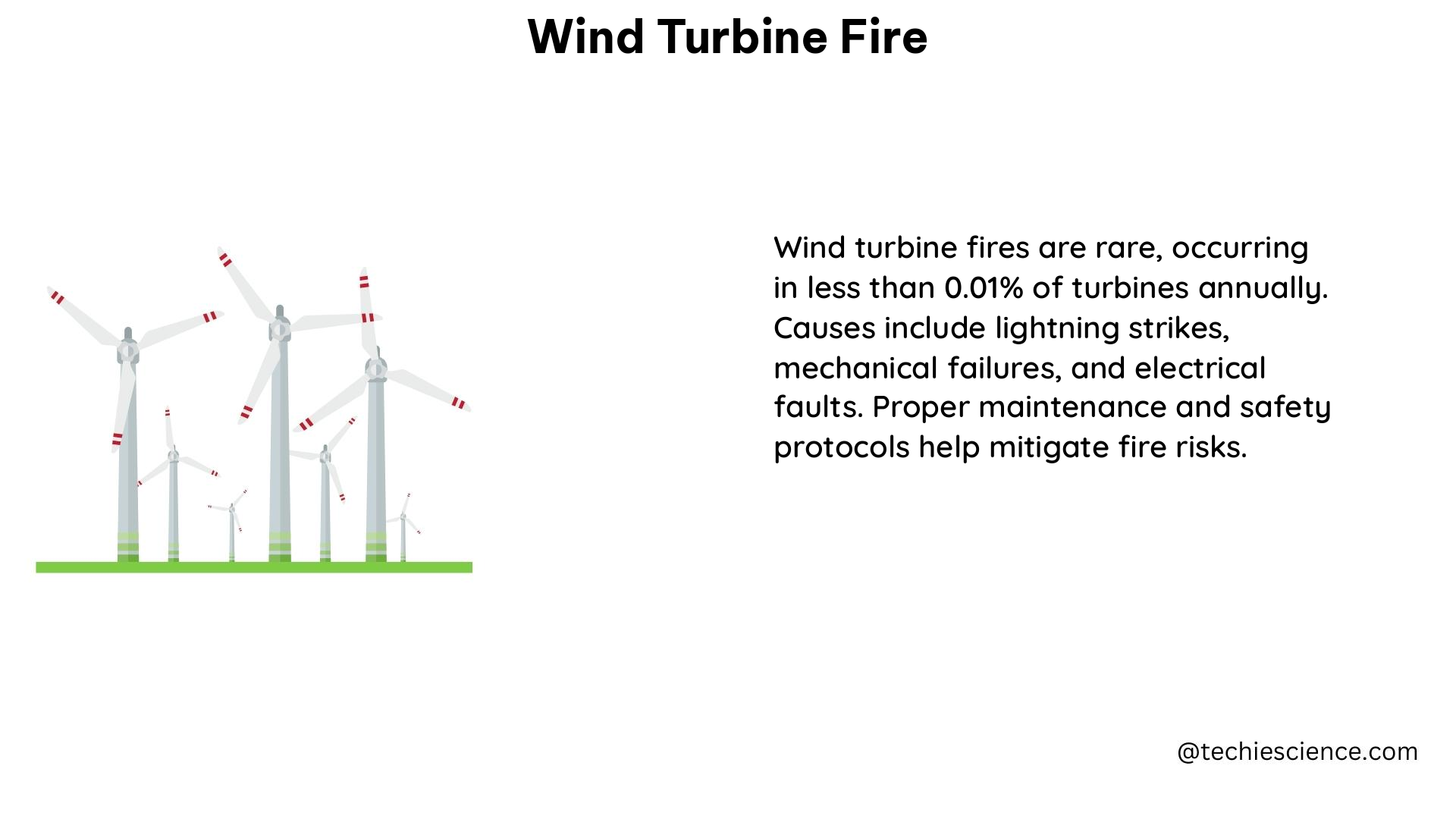Wind turbine fires are a significant concern in the renewable energy industry, accounting for a staggering 10-30% of all catastrophic wind turbine accidents. According to the Caithness Windfarm Information Forum (CWIF), there were 20 wind turbine fires globally in both 2011 and 2012, representing 12.5% of all incidents in those years. Fire is the second leading cause of reported accidents in wind turbines, with an average of 11.7 fires reported per year between 1995 and 2012. However, the International Association for Fire Safety Science (IAFSS) estimates that a staggering 91% of wind turbine incidents are never reported, indicating a much higher frequency of fires than what is officially documented.
The Alarming Rate of Wind Turbine Fires
The rate of wind turbine fires is estimated to be 1 in 1,710 turbines, based on data from 2011, when there were 200,000 wind turbines operating globally and 117 fires (both reported and unreported). The DNV GL analysis, which examined all wind turbine fires, regardless of whether the fire resulted in a total loss of the turbine, estimates the rate of fire in wind turbines at 1 in 2,000 each year. A 2020 article in Wind Power Engineering Magazine also estimates that 1 in 2,000 wind turbines catch fire each year.
| Year | Number of Wind Turbines | Number of Fires | Fire Rate |
|---|---|---|---|
| 2011 | 200,000 | 117 | 1 in 1,710 |
| Annual | – | – | 1 in 2,000 |
The Devastating Consequences of Wind Turbine Fires

When a fire does occur, the typical action is to wait for it to burn out, which often results in significant structural damage and total loss in nearly all cases (90%). The capital cost of replacing a turbine is significant, and downtime can add up quickly, leading to substantial financial losses for wind farm operators.
According to a Reddit post, a tragic incident occurred where two engineers were trapped on top of a wind turbine that was on fire. One of the engineers jumped to their death, while the other was burned alive, highlighting the dire consequences of these fires.
Mitigating the Risks with Fire Suppression Technology
Fortunately, cost-effective fire suppression technology can help to mitigate the risks of wind turbine fires. Firetrace systems, for example, automatically detect and suppress fires at their source, and are self-contained and do not require electricity or a water supply to operate, making them a feasible solution for wind turbine fire protection.
These systems use a pressurized detection tubing that runs throughout the turbine, which triggers the release of a fire-extinguishing agent when a fire is detected. This rapid response can significantly reduce the damage caused by a fire and increase the chances of the turbine being salvaged.
Improving Reporting and Data Collection
To better understand the true scale of the wind turbine fire problem, it is crucial to improve reporting and data collection efforts. The IAFSS estimate that 91% of wind turbine incidents are never reported highlights the need for a more comprehensive and transparent approach to incident reporting.
By implementing mandatory reporting requirements and establishing centralized databases, the wind energy industry can gain a clearer picture of the frequency and causes of wind turbine fires. This information can then be used to develop more effective prevention and mitigation strategies, ultimately reducing the risk of these devastating incidents.
Conclusion
Wind turbine fires pose a significant threat to the renewable energy industry, with an estimated rate of 1 in 2,000 turbines catching fire each year. The devastating consequences of these fires, including total loss of the turbine and potential loss of life, underscores the urgent need for the industry to address this issue.
By investing in advanced fire suppression technology, improving reporting and data collection, and implementing comprehensive safety protocols, wind farm operators can take proactive steps to mitigate the risks of wind turbine fires and ensure the continued growth and sustainability of the renewable energy sector.
References:
– Wind power installations: implications for the claims industry. (2022-11-17). Retrieved from https://www.sedgwick.com/blog/wind-power-installations-implications-for-the-claims-industry/
– This picture tells the story of two engineers trapped on top of a wind turbine that’s on fire. Here they hug each other for a last time, one jumped, one burned. (2017-05-19). Retrieved from https://www.reddit.com/r/pics/comments/6c6idb/this_picture_tells_the_story_of_two_engineers/
– Data-Driven Damage Quantification of Floating Offshore Wind Turbine Platforms Based on Multi-Scale Encoder–Decoder with Self-Attention Mechanism. (2022-11-29). Retrieved from https://www.mdpi.com/2077-1312/10/12/1830
– Wind Turbine – an overview. (n.d.). Retrieved from https://www.sciencedirect.com/topics/agricultural-and-biological-sciences/wind-turbine
– The Wind Turbine Fire Problem, By the Numbers – Firetrace. (n.d.). Retrieved from https://www.firetrace.com/fire-protection-blog/wind-turbine-fire-statistics

The lambdageeks.com Core SME Team is a group of experienced subject matter experts from diverse scientific and technical fields including Physics, Chemistry, Technology,Electronics & Electrical Engineering, Automotive, Mechanical Engineering. Our team collaborates to create high-quality, well-researched articles on a wide range of science and technology topics for the lambdageeks.com website.
All Our Senior SME are having more than 7 Years of experience in the respective fields . They are either Working Industry Professionals or assocaited With different Universities. Refer Our Authors Page to get to know About our Core SMEs.